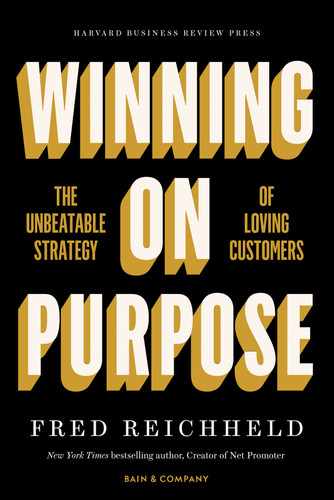APPENDIX B
Calculating Earned Growth
The illustrations on the following pages should help clarify the components of the earned growth calculation and their importance. Growth for every company results from the sum of its earned and bought revenues. By separating the two, we can better understand the quality and sustainability of the firm’s growth, thus improving our understanding of its future prospects. We also provide further instructions at the website, NetPromoterSystem.com, as well as an online earned growth calculator tool that we built to help guide the application of the ideas contained in these illustrations.
In figure B-1, the standard accounting process would show that the firm grew by 30 percent from revenues of $100 to $130 (this could represent thousands of dollars or millions—the proportion is what counts, and using 100 for base-year revenues simplifies all calculations) over the period covered. The third bar (far right) illustrates how customer-based accounting illuminates the underlying changes in customer flows and purchases yielding the 30 percent revenue growth. The bar shows that this 30 percent is the result of net revenue retention (NRR) of 85 percent (some existing customers reduced purchases while others expanded, netting out to a 15 percent decline). New customer purchases generated an extra 45 percent of revenues, 20 percent of which was bought and 25 percent of which was earned. To calculate earned growth, we add NRR of 85 percent to the 25 percent new customer earned revenues of 25 percent for an earned growth factor of 110 percent (which means a 10 percent Earned Growth Rate). In this example, the earned growth ratio is 33 percent; in other words, one-third of the reported growth rate (using standard accounting) was earned growth. Net Promoter Score leaders don’t need to buy new customers to grow, so you would expect them to have earned growth ratios much higher than 33 percent.
FIGURE B-1
Calculating the Earned Growth Rate (EGR)

Shortcut
Some firms won’t be able to calculate all the factors comprising NRR—for example, it may be impossible to quantify revenues lost through customer declines or defections—either through systems inadequacies or because their business has a long and unpredictable purchase cycle (such as automobiles and eyeglasses). No worries, because a simple shortcut will let you calculate your Earned Growth Rate. Simply quantify current period revenues from customers who had purchased from you previously and divide by total revenues (all customers) from the previous period. That will estimate your NRR.
Then, add your best estimate of earned new revenue (as a percent of total current period revenues) to derive your earned growth factor (and Earned Growth Rate, which is simply the factor minus 100 percent). As noted in chapter 5, earned new customer revenue (typically the much smaller component of earned growth) quantifies revenues from the subset of new customers who were earned through recommendations and referrals from existing customers. Today, few firms can parse new customers into earned versus bought, so we at Bain (in partnership with a team at Medallia) pioneered a practical solution to begin meeting this challenge. We provide more details on that solution at our website, NetPromoterSystem.com, but stated briefly, we tested out alternative structures for the question that can be integrated into the new-customer onboarding process.
Digging Deeper
Figure B-2 illustrates two hypothetical firms (A and B) with the same reported revenue growth using standard accounting, 30 percent. With customer-based accounting, the very different paths these firms have followed to achieve that growth are revealed by their contrasting Earned Growth Rates. Company A has better NRR and is benefiting from a healthy flow of referral/recommendation-generated new customers, while company B must buy lots of growth to make up for its weak NRR and paltry flow of earned new customer revenues. We would expect that company A’s NPS will be superior relative to B’s (if relative scores are available) and that A will enjoy far superior economics over the years ahead if these patterns hold. If these were public companies priced at similar multiples to earnings or revenues, it would probably make sense to invest in company A and take a short position against company B.
FIGURE B-2
Two companies: identical nominal growth, different sustainable growth

